Foraging wild lemon balm is an exciting way to create unique tea blends that invigorate your senses. This vibrant herb boasts a delightful lemony flavor and calming properties, making it perfect for stress relief and relaxation. By harvesting fresh leaves, you can explore various pairings, like ginger or honey, that enhance your tea's taste. The experience of foraging connects you with nature, adding an extra layer of enjoyment. Plus, lemon balm's health benefits, such as digestive support and antioxidant content, make your tea not just tasty, but nourishing. Discover how to fully enjoy this herbal adventure as you explore further.
What Is Wild Lemon Balm?

What makes wild lemon balm so special? It's a vibrant herb, belonging to the mint family, known for its delightful lemony scent and flavor. Often found in sunny, moist areas, this perennial plant can thrive in gardens and along forest edges. You'll recognize it by its jagged, bright green leaves and tiny white flowers that attract pollinators.
When you forage for wild lemon balm, you engage with nature in a hands-on way. It's not just about collecting leaves; it's about discovering the plant's unique habitat. The leaves release a revitalizing aroma when you gently crush them, instantly uplifting your spirits.
This herb has a rich history, often used in traditional remedies and culinary dishes, giving it a depth that connects you to various cultures. As you explore, keep in mind that wild lemon balm can be easily confused with similar plants. Familiarizing yourself with its distinct characteristics will help guarantee you forage safely.
Health Benefits of Lemon Balm
Lemon balm isn't just a fragrant addition to your tea; it also offers a variety of health benefits that make it a worthwhile forage. This herb is known for its calming properties, which can help reduce stress and anxiety. When you sip on lemon balm tea, you're not just enjoying the taste; you're also promoting relaxation and a sense of well-being.
Additionally, lemon balm contains antioxidants that contribute to overall health. These compounds help combat oxidative stress in your body, potentially lowering the risk of chronic diseases.
If you're struggling with digestive issues, lemon balm may aid in soothing your stomach, relieving symptoms like bloating and gas.
Moreover, lemon balm has antiviral properties, which can be beneficial in fighting off certain viruses, including herpes simplex. By incorporating it into your tea blends, you can harness these effects while enjoying a delightful beverage.
Lastly, some studies suggest that lemon balm might improve cognitive function and memory, making it an excellent choice for when you need to focus.
Foraging Tips for Beginners

For anyone new to foraging, starting can feel a bit overwhelming, but with a few simple tips, you'll be gathering herbs like lemon balm in no time.
Here are three essential tips to get you started:
1. Research Your Area: Before you head out, familiarize yourself with the types of plants in your region. Local foraging guides or apps can help you identify common herbs, including lemon balm.
Understanding where it grows best will save you time and effort.
2. Choose the Right Time: Foraging during spring and summer is ideal since lemon balm is most vibrant and flavorful then.
Early morning is the best time for harvesting, as the plants are fresh and full of essential oils.
3. Respect Nature: Always forage responsibly.
Take only what you need and leave enough for the plant to continue thriving. This guarantees you'll have a sustainable source for future foraging trips.
Identifying Wild Lemon Balm
When you're out foraging, look for wild lemon balm's distinctive square stems and bright green, serrated leaves.
If you crush a leaf, you'll notice its invigorating lemon scent that sets it apart from other herbs.
This unique aroma and flavor profile is what makes lemon balm a delightful addition to your tea blends.
Distinctive Leaf Characteristics
Identifying wild lemon balm involves recognizing its distinctive leaf characteristics that set it apart from other herbs. You'll find that these features make it easy to spot during your foraging adventures.
- Shape and Size: The leaves are broadly oval with a slightly serrated edge, measuring about 1 to 2 inches in length. This unique shape helps differentiate lemon balm from similar herbs.
- Color: Look for a vibrant green hue that can appear a bit glossy. The leaves are often lighter on the underside, which adds to their overall charm and makes them stand out in the wild.
- Texture: When you touch the leaves, you'll notice they've a soft, velvety texture. This tactile quality is a hallmark of lemon balm and can help you confirm your identification.
Scent and Flavor Profile
The unmistakable scent of wild lemon balm is one of its most fascinating features, making it a joy to encounter during your foraging excursions. As you brush your fingers against its leaves, you'll immediately notice a bright, citrusy aroma that can invigorate your senses. This revitalizing scent is a telltale sign that you've found the right plant.
When you steep wild lemon balm in hot water, its flavor profile unfolds beautifully. You'll experience a gentle sweetness paired with a zesty lemon undertone that brightens up any tea blend. The taste is smooth and soothing, with a hint of earthiness that grounds the overall experience.
This unique combination makes it a perfect companion for other herbs, allowing you to create delightful infusions that are both flavorful and aromatic.
If you're looking to enhance your tea blends, wild lemon balm is an excellent choice. Its mesmerizing scent and delightful taste can transform your brews into something truly special.
Harvesting Lemon Balm Safely

Harvesting lemon balm safely requires a few key steps to confirm you're collecting the herb without harming yourself or the plant.
First, familiarize yourself with the plant's appearance. Lemon balm has bright green, serrated leaves and a pleasant lemon scent, which makes it relatively easy to identify.
Next, choose the right time for harvesting. Early morning is ideal since the leaves are full of essential oils and flavors. Avoid harvesting in the heat of the day, as this can diminish the herb's potency.
Finally, use proper harvesting techniques:
- Cut selectively: Trim only a few stems at a time, allowing the plant to continue growing. Aim for cutting above the leaf nodes to encourage new growth.
- Wear gloves: If you're sensitive to plants, wearing gloves can protect your skin from potential irritations.
- Check for pests and pollution: Confirm the area is free from pesticides and pollutants. Avoid harvesting from areas near busy roads or treated gardens.
Preparing Lemon Balm for Tea
Once you've safely harvested your lemon balm, it's time to prepare it for tea. Start by rinsing the leaves gently under cool water to remove any dirt or bugs.
Pat them dry with a clean cloth or paper towel to avoid excess moisture, which could dilute your tea.
Next, you'll want to chop or tear the leaves into smaller pieces. This increases the surface area, allowing more flavor to be released during steeping.
If you prefer, you can also use whole leaves, but you may not achieve the same depth of flavor.
Decide how much lemon balm you want to use; a good rule of thumb is about one tablespoon of fresh leaves per cup of water.
If you're using dried lemon balm, use about one teaspoon per cup.
Now, you can either steep the leaves directly in hot water or place them in a tea infuser for easy removal later.
If you're feeling adventurous, consider mixing in other herbs or ingredients to create a unique blend.
Once you've prepared your lemon balm, you're ready to enjoy a revitalizing cup of tea!
Classic Lemon Balm Tea Recipe
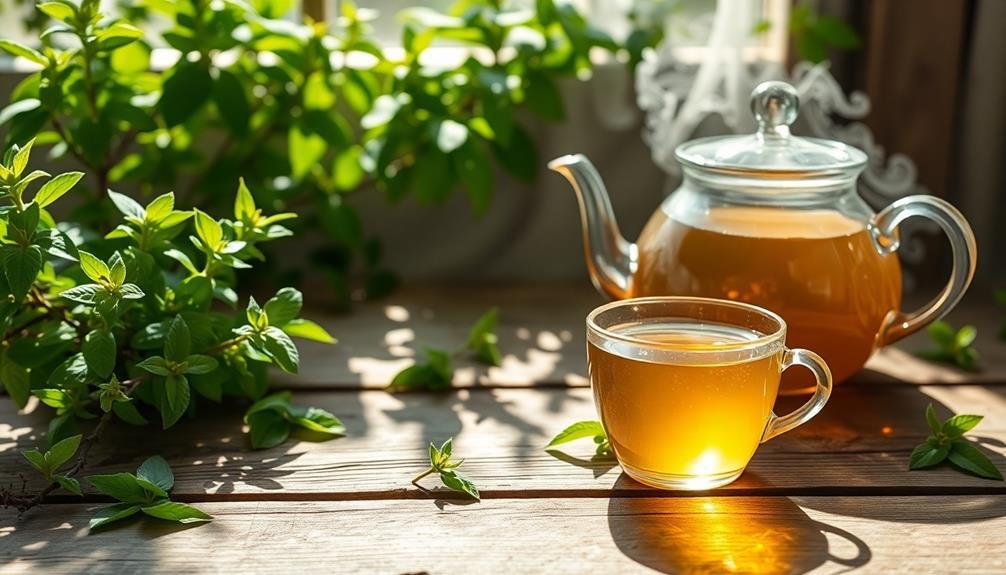
When you make classic lemon balm tea, you're not just enjoying a soothing beverage; you're also tapping into a range of health benefits.
Understanding the brewing techniques can enhance your experience, and experimenting with flavor pairings can elevate your tea to new heights.
Let's explore how to brew the perfect cup and discover what flavors complement lemon balm beautifully.
Benefits of Lemon Balm
Lemon balm's soothing properties make it a favorite for tea enthusiasts seeking relaxation and comfort. This versatile herb not only delights your senses but also offers several health benefits that enhance your tea experience. When you brew a cup, you can enjoy the following advantages:
- Stress Relief: Lemon balm is known for its calming effects. It can help reduce anxiety and promote a sense of peace, making it an ideal choice for unwinding after a long day.
- Sleep Aid: If you struggle with insomnia or restless nights, lemon balm tea can help. Its sedative properties may improve sleep quality, helping you drift off more easily and wake up refreshed.
- Digestive Support: Sipping on lemon balm tea can aid digestion by alleviating bloating and discomfort. It's particularly beneficial after a heavy meal, allowing your digestive system to function smoothly.
Incorporating lemon balm into your daily routine can transform your tea time into a soothing ritual.
Whether you forage for it or purchase it, the experience of enjoying lemon balm tea is sure to enhance your well-being.
Brewing Techniques Explained
To fully enjoy the soothing benefits of lemon balm, mastering the brewing techniques is key. Start by gathering fresh lemon balm leaves—about a cup will do. Rinse them gently to remove any dirt or insects.
Next, tear or chop the leaves to release their essential oils, enhancing the flavor.
Boil water in a kettle, aiming for around 200°F, or just before it reaches a rolling boil. Place the prepared leaves in a teapot or infuser, then pour the hot water over them. Allow the tea to steep for about 5 to 10 minutes, depending on how strong you like it. The longer it steeps, the more intense the flavor will be.
Once steeped, strain the leaves or remove the infuser. You can enjoy your lemon balm tea as is, or sweeten it with honey for added flavor.
If you're feeling adventurous, consider adding a splash of lemon juice for a revitalizing twist. Serve it warm or chill it over ice for a cool drink.
Experimenting with steeping times and temperatures will help you find your perfect cup. Enjoy this delightful infusion and its calming effects!
Flavor Pairing Ideas
Crafting the perfect lemon balm tea involves more than just steeping the leaves; it's all about the flavor pairings that elevate your brew.
When you combine lemon balm's invigorating, citrusy notes with other ingredients, you create a delightful tea experience that tantalizes your taste buds. Here are three flavor pairing ideas to enhance your lemon balm tea:
1. Ginger: Adding fresh ginger root brings a warm, spicy kick that complements lemon balm's brightness.
It's perfect for soothing digestion and boosting your immune system.
2. Honey: A touch of honey not only sweetens your tea but also adds a rich, floral undertone that balances the herbal notes of lemon balm.
This pairing is especially comforting during colder months.
3. Mint: For an invigorating twist, mix in some fresh mint leaves.
The coolness of mint harmonizes beautifully with the lemony flavor, creating a revitalizing drink for hot summer days.
Experiment with these combinations to find your favorite blend.
Each pairing highlights lemon balm's unique characteristics, making your tea an enjoyable ritual.
Unique Blends With Lemon Balm
Exploring unique blends with lemon balm can elevate your tea experience to new heights. This aromatic herb, with its fresh citrusy notes, serves as a fantastic base for various tea concoctions.
You might enjoy blending lemon balm with green tea for a revitalizing twist. The grassy undertones of the green tea complement the zesty flavor of lemon balm, creating a vibrant and invigorating beverage.
Another delightful option is mixing lemon balm with rooibos. The naturally sweet and nutty profile of rooibos pairs beautifully with lemon balm, resulting in a caffeine-free herbal infusion that's perfect for any time of day.
You could also try combining lemon balm with chamomile, which brings a soothing quality to your cup. The floral notes of chamomile, combined with lemon balm's uplifting essence, create a calming tea that's perfect for winding down.
If you're feeling adventurous, consider adding lemon balm to a chai blend. The spicy warmth of chai spices combined with lemon balm's brightness creates a unique fusion that's both comforting and energizing.
Experimenting with these unique blends will surely enhance your tea-drinking experience, inviting new flavors and aromas into your daily routine.
Pairing Lemon Balm With Other Herbs
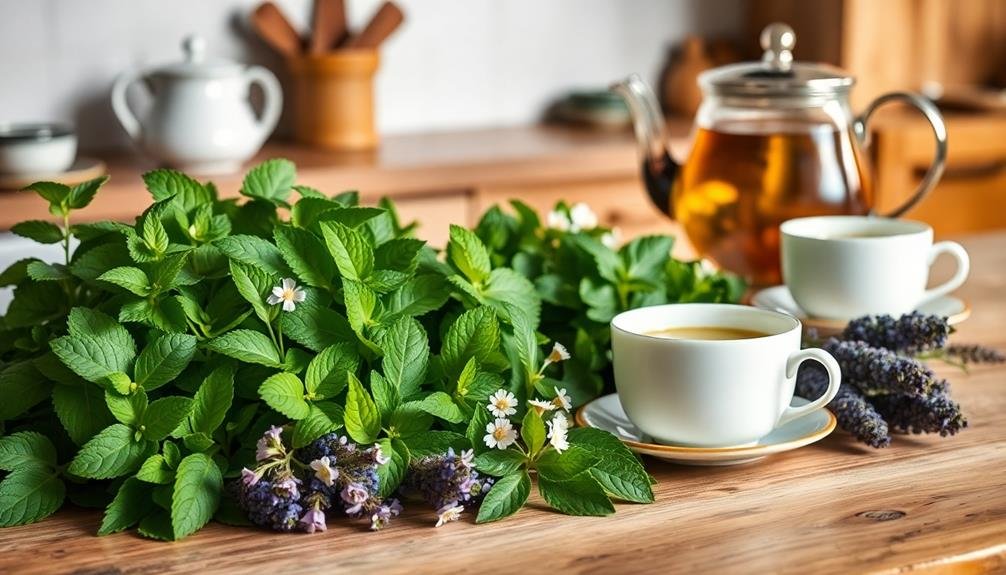
When you're considering ways to elevate your tea blends, pairing lemon balm with other herbs opens up a world of flavor possibilities. This delightful herb not only boasts a revitalizing lemony taste but also complements a variety of other flavors.
Here are three fantastic herb pairings to try:
- Peppermint: The coolness of peppermint enhances lemon balm's citrusy notes, creating a rejuvenating blend that's perfect for hot summer days.
- Chamomile: Combining lemon balm with chamomile results in a soothing tea that promotes relaxation. The gentle sweetness of chamomile balances the citrusy brightness of lemon balm, making it an ideal evening drink.
- Thyme: For a more adventurous blend, try adding thyme. The earthy, aromatic quality of thyme complements lemon balm's lightness, resulting in a tea that's both invigorating and herbaceous.
Experimenting with these pairings can lead to unique flavor profiles that elevate your tea experience.
Whether you're looking for relaxation or a revitalizing pick-me-up, lemon balm's versatility makes it a fantastic companion for other herbs.
Storage and Preservation Techniques
Preserving the freshness and flavor of your foraged lemon balm is essential for enjoying its benefits long after the harvest. Start by washing the leaves gently to remove any dirt or insects.
Pat them dry with a clean towel or let them air dry, guaranteeing no moisture remains, as this can lead to mold during storage.
For short-term storage, wrap the leaves in a damp paper towel and place them in a sealed plastic bag in the refrigerator. They'll stay fresh for about a week this way.
If you want to keep them longer, consider drying them. Simply tie the stems together and hang them upside down in a warm, dry, and dark place. Once fully dried, crumble the leaves and store them in an airtight container away from light and heat.
Another option is to freeze the leaves. Chop them and place them in ice cube trays, covering them with water or olive oil.
Once frozen, transfer the cubes to a freezer bag for easy access later. By using these techniques, you'll guarantee your lemon balm retains its unique flavor and aroma for your future tea blends.
Enjoying Your Herbal Tea Experience

When you brew your herbal tea, think about how to enhance the flavor profiles with wild lemon balm's unique zest.
Notice the aromatic qualities that fill your space, inviting a moment of relaxation.
Plus, don't forget to appreciate the health benefits that come with each soothing sip.
Enhancing Flavor Profiles
Many tea enthusiasts revel in the opportunity to enhance their herbal blends, and lemon balm is a perfect candidate for this purpose. Its light, citrusy notes can transform your tea experience, making it both invigorating and flavorful.
Here are three simple ways to enhance the flavor profiles of your lemon balm tea:
- Add Citrus Zest: A sprinkle of lemon or orange zest can elevate the brightness of lemon balm, creating a zesty, invigorating blend.
- Incorporate Spices: A pinch of ginger or cinnamon can introduce warmth and depth, balancing the herbal qualities of lemon balm with a spicy kick.
- Sweeten Naturally: Consider using honey or agave nectar to sweeten your tea. This not only complements the lemon balm but also adds a touch of natural sweetness that rounds out the flavor.
Aromatic Qualities Explored
The aromatic qualities of lemon balm tea can greatly enhance your overall herbal experience, inviting you to savor each sip. As you brew this delightful tea, the enchanting scent of fresh lemon balm fills the air, creating an inviting atmosphere that sets the stage for relaxation.
The bright, citrusy aroma dances with subtle herbal notes, making it a perfect companion for your afternoon or evening ritual. When you take that first sip, the fragrance intensifies, wrapping you in a warm embrace.
You'll notice how the aroma complements the flavor, creating a harmonious balance that soothes your senses. This unique scent can evoke memories of sunlit gardens and tranquil moments, transporting you away from the hustle and bustle of daily life.
Experimenting with different preparations can further enhance your experience. Try adding other herbs or spices, like peppermint or ginger, to create a layered aroma that excites your senses even more.
Each blend offers a new adventure, showcasing the versatility of lemon balm. So, brew a cup, inhale deeply, and let the aromatic qualities of lemon balm tea elevate your herbal journey to new heights.
Health Benefits Highlighted
Sipping lemon balm tea not only delights your senses but also offers a range of health benefits that can greatly enhance your overall well-being.
This herbal infusion is packed with properties that can markedly improve your quality of life. Here are three notable advantages you'll enjoy:
- Stress Relief: Lemon balm is known for its calming effects. Drinking this tea can help reduce anxiety and promote relaxation, making it perfect for winding down after a long day.
- Digestive Support: If you're prone to digestive issues, lemon balm tea can soothe your stomach. It may help alleviate discomfort and improve digestion, allowing you to feel your best.
- Antioxidant Properties: This herbal tea is rich in antioxidants, which can help combat oxidative stress in your body.
Frequently Asked Questions
Can I Grow Lemon Balm From Seeds After Foraging?
Yes, you can grow lemon balm from seeds after foraging. Just collect mature seeds, plant them in well-drained soil, and keep them moist. They'll thrive with sunlight, and soon you'll have your own lemon balm plants.
Are There Any Look-Alike Plants to Avoid?
Yes, you should be cautious. Look-alikes include catnip and mint. To avoid confusion, check the leaf shape and smell; lemon balm has a distinct lemon scent. Familiarize yourself with the differences before foraging.
How Does Wild Lemon Balm Differ From Cultivated Varieties?
Wild lemon balm tends to have a stronger, more intense flavor compared to cultivated varieties. You'll notice its scent is often more aromatic, adding depth to your blends. Plus, wild plants can offer unique health benefits.
Can I Forage Lemon Balm Year-Round?
You can forage lemon balm during the growing season, typically from spring to early fall. In colder months, it dies back, so you'll need to wait until warmer weather returns for fresh leaves.
What Environmental Factors Affect Wild Lemon Balm Growth?
Environmental factors like soil quality, moisture levels, and sunlight greatly affect wild lemon balm's growth. You'll notice it thrives in well-drained soil and prefers partial shade, so keep those conditions in mind when foraging.
In Summary
Foraging wild lemon balm can elevate your tea experience with its delightful flavor and health benefits. By learning to identify and harvest this herb safely, you open the door to unique blends that can refresh and soothe. Pair it with other herbs for a personalized touch, and use proper storage techniques to keep your harvest fresh. So, grab your basket and explore the outdoors—there's a world of herbal possibilities waiting for you! Enjoy your brewing adventures!


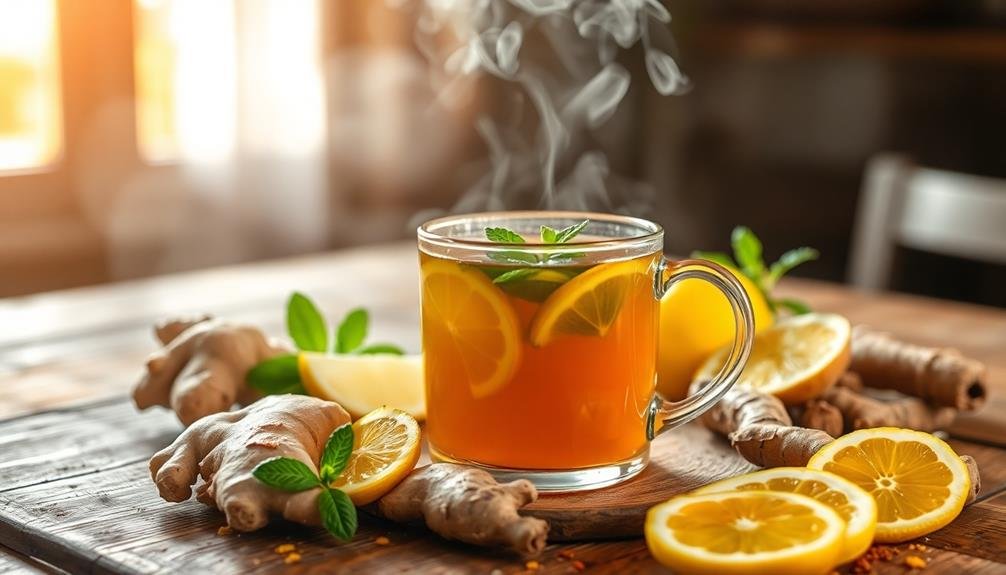
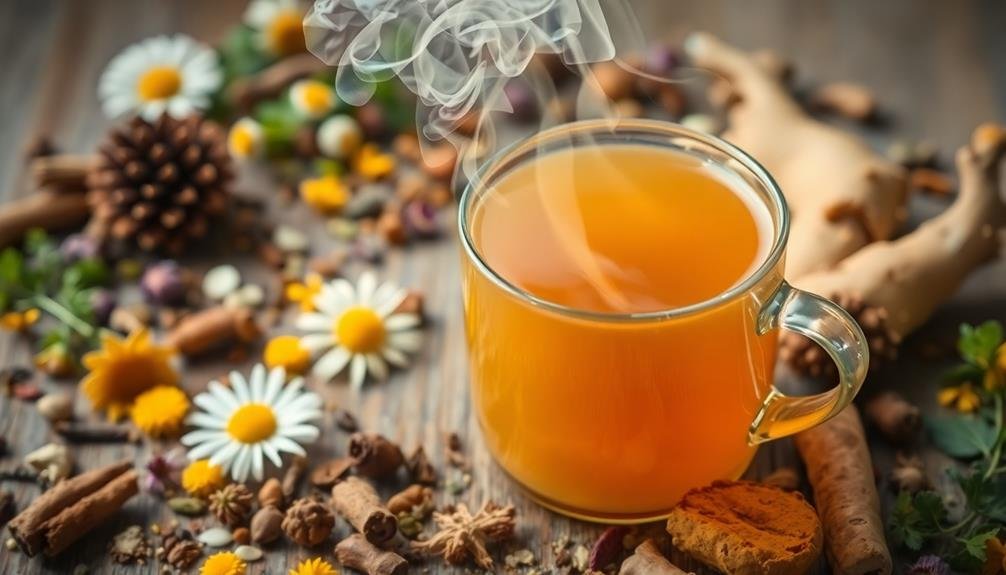
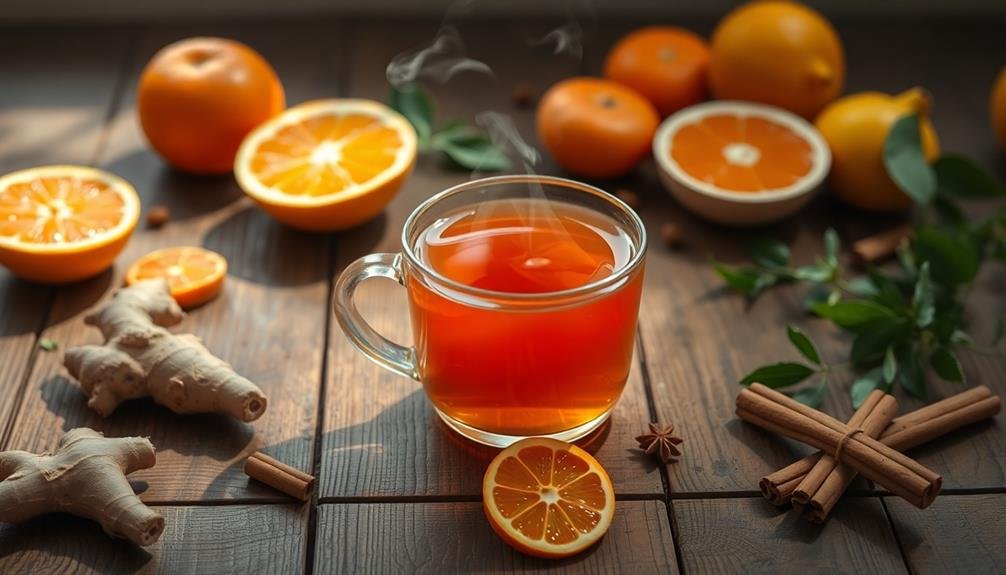
Leave a Reply